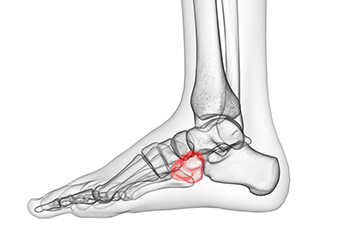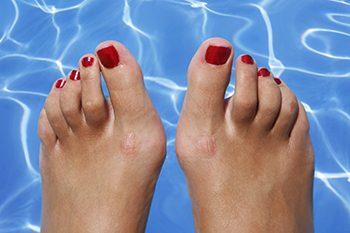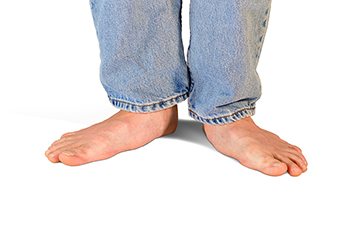Items filtered by date: May 2023
Several Categories of Foot Bones

The foot bones are responsible for the mobility of the body, in addition to providing mechanical support for the soft tissues. This is necessary to support the body’s weight while standing and moving. Three categories of bones are in each foot. The tarsals consist of seven bones that are located in the ankle area. The bones in the toes are known as phalanges and connect to the metatarsals, the third group of bones. Additionally, the foot is divided into three areas referred to as the hindfoot, midfoot, and forefoot. Each part of the foot has different functions which work in unison to help you walk and run. The bones in the foot may break when enduring a stress fracture or from a sudden injury. If you would like additional information about the bones in the feet, it is suggested that you confer with a podiatrist who can provide you with the knowledge you are seeking.
If you have any concerns about your feet, contact one of our podiatrists from Suncoast Podiatry Associates. Our doctors can provide the care you need to keep you pain-free and on your feet.
Biomechanics in Podiatry
Podiatric biomechanics is a particular sector of specialty podiatry with licensed practitioners who are trained to diagnose and treat conditions affecting the foot, ankle and lower leg. Biomechanics deals with the forces that act against the body, causing an interference with the biological structures. It focuses on the movement of the ankle, the foot and the forces that interact with them.
A History of Biomechanics
- Biomechanics dates back to the BC era in Egypt where evidence of professional foot care has been recorded.
- In 1974, biomechanics gained a higher profile from the studies of Merton Root, who claimed that by changing or controlling the forces between the ankle and the foot, corrections or conditions could be implemented to gain strength and coordination in the area.
Modern technological improvements are based on past theories and therapeutic processes that provide a better understanding of podiatric concepts for biomechanics. Computers can provide accurate information about the forces and patterns of the feet and lower legs.
Understanding biomechanics of the feet can help improve and eliminate pain, stopping further stress to the foot.
If you have any questions please feel free to contact our office located in Ocala, FL . We offer the newest diagnostic and treatment technologies for all your foot and ankle needs.
What Does Cuboid Syndrome Feel Like?

Cuboid syndrome is a specific condition of the foot that occurs when the cuboid bone moves out of alignment. Many patients often wonder what exactly cuboid syndrome feels like, and what symptoms are typically noticed. When an individual has cuboid syndrome, they may find it is challenging to walk. To compensate for this difficulty some patients may realize they are walking on their toes to avoid putting pressure on affected parts of their feet. Additionally, the lateral part of the foot that is affected by cuboid syndrome can become tender and swollen, and the overall foot may ache. If you are someone that is currently living with cuboid syndrome, it is suggested that you contact a podiatrist immediately for treatment.
Cuboid syndrome, also known as cuboid subluxation, occurs when the joints and ligaments near the cuboid bone in the foot become torn. If you have cuboid syndrome, consult with one of our podiatrists from Suncoast Podiatry Associates. Our doctors will assess your condition and provide you with quality foot and ankle treatment.
Cuboid syndrome is a common cause of lateral foot pain, which is pain on the outside of the foot. The condition may happen suddenly due to an ankle sprain, or it may develop slowly overtime from repetitive tension through the bone and surrounding structures.
Causes
The most common causes of cuboid syndrome include:
- Injury – The most common cause of this ailment is an ankle sprain.
- Repetitive Strain – Tension placed through the peroneus longus muscle from repetitive activities such as jumping and running may cause excessive traction on the bone causing it to sublux.
- Altered Foot Biomechanics – Most people suffering from cuboid subluxation have flat feet.
Symptoms
A common symptom of cuboid syndrome is pain along the outside of the foot which can be felt in the ankle and toes. This pain may create walking difficulties and may cause those with the condition to walk with a limp.
Diagnosis
Diagnosis of cuboid syndrome is often difficult, and it is often misdiagnosed. X-rays, MRIs and CT scans often fail to properly show the cuboid subluxation. Although there isn’t a specific test used to diagnose cuboid syndrome, your podiatrist will usually check if pain is felt while pressing firmly on the cuboid bone of your foot.
Treatment
Just as the range of causes varies widely, so do treatments. Some more common treatments are ice therapy, rest, exercise, taping, and orthotics.
If you have any questions, please feel free to contact our office located in Ocala, FL . We offer the newest diagnostic and treatment technologies for all your foot care needs.
Athlete's Foot in Swimmers

Athlete's foot is a particular kind of fungal infection that impacts the feet. When an individual has athlete’s foot, they may experience redness and flakiness at the site of infection, which is typically between the toes. Some groups of people might be more susceptible to athlete’s foot than others. For example, swimmers are one such group of people. The fungus causing athlete’s foot thrives in warm, moist environments, like the sides of pools and in shower areas of locker rooms. Additionally, since many swimmers walk around pool sides barefoot, they can easily pick up the fungus that causes athlete’s foot. If you are a swimmer that is looking to prevent the onset of athlete's foot, it is highly suggested that you contact a podiatrist today for more information.
Athlete’s foot is an inconvenient condition that can be easily reduced with the proper treatment. If you have any concerns about your feet and ankles, contact one of our podiatrists from Suncoast Podiatry Associates. Our doctors will treat your foot and ankle needs.
Athlete’s Foot: The Sole Story
Athlete's foot, also known as tinea pedis, can be an extremely contagious foot infection. It is commonly contracted in public changing areas and bathrooms, dormitory style living quarters, around locker rooms and public swimming pools, or anywhere your feet often come into contact with other people.
Solutions to Combat Athlete’s Foot
- Hydrate your feet by using lotion
- Exfoliate
- Buff off nails
- Use of anti-fungal products
- Examine your feet and visit your doctor if any suspicious blisters or cuts develop
Athlete’s foot can cause many irritating symptoms such as dry and flaking skin, itching, and redness. Some more severe symptoms can include bleeding and cracked skin, intense itching and burning, and even pain when walking. In the worst cases, Athlete’s foot can cause blistering as well. Speak to your podiatrist for a better understanding of the different causes of Athlete’s foot, as well as help in determining which treatment options are best for you.
If you have any questions please feel free to contact our office located in Ocala, FL . We offer the newest diagnostic and treatment technologies for all your foot and ankle needs.
Types and Causes of Flat Feet

Having flat feet, medically known as pes planus, is the result of collapsed arches that absorb the shock of each step you take. The three main types of flat feet are flexible pes planus, posterior tibial dysfunction, and a tight Achilles tendon. Flexible flat feet is the most common type, indicated if the arch disappears when the foot bears weight. It is generally not painful, and with proper arch support can be contained. If the posterior Achilles tendon is torn, swollen, or has become injured, flat feet can result. This type can be caused by obesity, hypertension, or diabetes. When the tension between the calf muscles and the Achilles tendon is too tight, it may cause arch pain when you are active. Most babies are born with flat feet, and the arches develop as the baby grows, so it should not be a cause for alarm. In adults, however, it may be harmful to ignore flat feet, because the pain from overpronation can spread to the legs, knees, hips, and back. For help with any type of flat feet, it is suggested that you make an appointment with a podiatrist who can provide proper treatment options.
Flatfoot is a condition many people suffer from. If you have flat feet, contact one of our podiatrists from Suncoast Podiatry Associates. Our doctors will treat your foot and ankle needs.
What Are Flat Feet?
Flatfoot is a condition in which the arch of the foot is depressed and the sole of the foot is almost completely in contact with the ground. About 20-30% of the population generally has flat feet because their arches never formed during growth.
Conditions & Problems:
Having flat feet makes it difficult to run or walk because of the stress placed on the ankles.
Alignment – The general alignment of your legs can be disrupted, because the ankles move inward which can cause major discomfort.
Knees – If you have complications with your knees, flat feet can be a contributor to arthritis in that area.
Symptoms
- Pain around the heel or arch area
- Trouble standing on the tip toe
- Swelling around the inside of the ankle
- Flat look to one or both feet
- Having your shoes feel uneven when worn
Treatment
If you are experiencing pain and stress on the foot you may weaken the posterior tibial tendon, which runs around the inside of the ankle.
If you have any questions please feel free to contact our office located in Ocala, FL . We offer the newest diagnostic and treatment technologies for all your foot and ankle needs.
